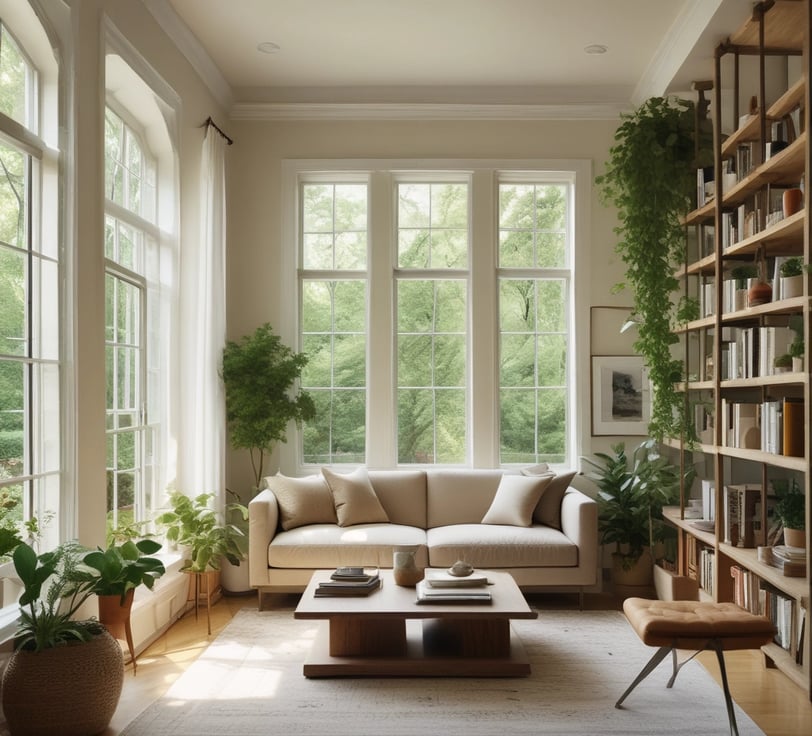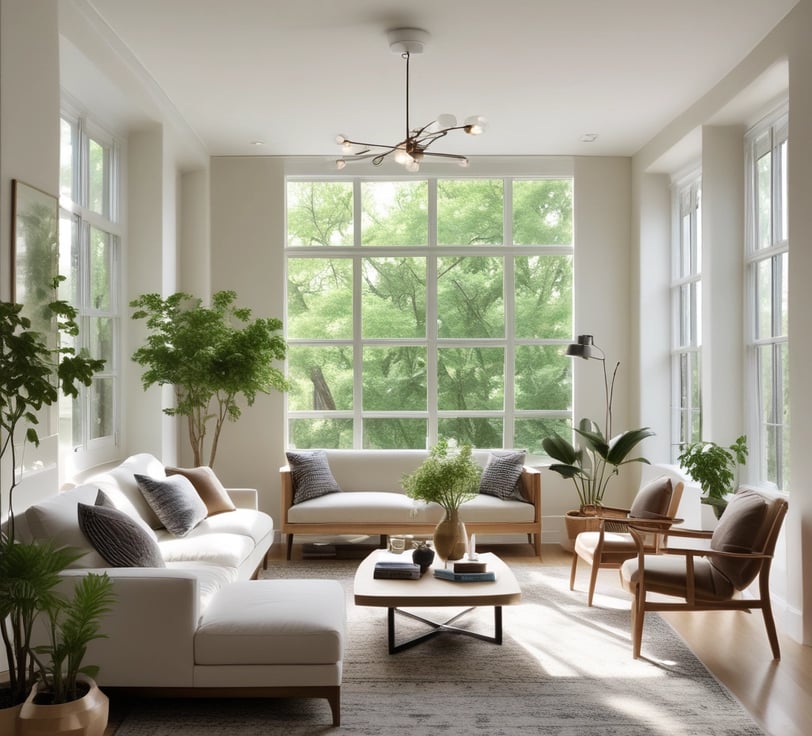
What Is Interior Design? — "A Beginner’s Guide to Transforming Your Space"
Interior design is the art and science of crafting indoor spaces that are both beautiful and functional, tailored to reflect personal style and enhance daily living. Whether you're revamping a cozy apartment or a sprawling home, understanding the basics of interior design can turn any space into a sanctuary. This guide dives into its core principles, practical tips, and trending ideas to help you get started.
Dennis Yang


What Is Interior Design?
At its heart, interior design is about creating environments that work for you. It’s more than picking paint colors or arranging furniture—it’s a thoughtful process blending aesthetics, practicality, and comfort. Designers use principles like balance, harmony, and proportion to shape spaces that feel cohesive and inviting. For example, a well-designed living room might combine soft lighting, neutral tones, and plush textures to foster relaxation, while a home office could prioritize ergonomic furniture and vibrant accents to boost productivity.
Interior design also considers how spaces are used. A family-friendly kitchen needs durable surfaces and open layouts, whereas a minimalist bedroom might focus on clean lines and clutter-free serenity. By aligning form with function, interior design ensures your home not only looks good but feels right.


Why Interior Design Matters
A thoughtfully designed space can transform how you live. Studies show that environments impact mood and well-being—bright, airy rooms can reduce stress, while cluttered spaces may heighten anxiety. Interior design helps you control these effects, creating rooms that inspire joy, calm, or creativity. For instance, incorporating natural elements like plants or wood can evoke tranquility, a principle rooted in biophilic design trends gaining traction in 2025.
Beyond personal benefits, great design adds value. Homes with cohesive, stylish interiors often attract higher resale prices, as buyers are drawn to move-in-ready spaces. Whether you’re decorating for yourself or future buyers, interior design is an investment in comfort and appeal.


Key Principles of Interior Design
To grasp interior design, start with its foundational principles:
Balance: Distribute visual weight evenly. Symmetrical balance (matching items on either side of a room) feels formal, while asymmetrical balance (mixing different objects for harmony) adds dynamism.
Harmony: Ensure colors, textures, and furniture complement each other. A harmonious room feels unified, like a coastal-themed space with blues, whites, and woven textures.
Proportion and Scale: Choose furniture that fits your space. A massive sofa overwhelms a small room, while a tiny rug looks lost in a large one.
Color: Colors set the mood. Warm tones (reds, yellows) energize, while cool tones (blues, greens) soothe. Neutrals offer versatility, trending heavily in 2025 for their timeless appeal.
Texture: Mix materials—think velvet cushions, wooden tables, or metallic accents—to add depth. Textured spaces feel layered and inviting.
These principles guide every design decision, helping you create spaces that feel intentional and polished.


How to Start Designing Your Space
Ready to try interior design yourself? Here’s a step-by-step approach:
Define Your Goals: What do you want from the space? A cozy bedroom for rest, a vibrant kitchen for entertaining? Clarifying your needs sets the direction.
Find Inspiration: Browse platforms like Pinterest or Instagram for ideas. In 2025, trends lean toward sustainable materials (bamboo, recycled fabrics) and bold accents (jewel-toned walls, statement lighting).
Set a Budget: Prioritize spending—splurge on timeless pieces like a sofa, save on decor like throw pillows. Secondhand stores or online marketplaces can yield unique finds.
Plan the Layout: Sketch your room’s floor plan, ensuring furniture placement supports flow. Tools like RoomSketcher or Planner 5D make this easy.
Experiment with Color and Texture: Start with a neutral base, then layer in pops of color or tactile elements. For example, a beige living room comes alive with emerald cushions and a jute rug.
Add Personal Touches: Display art, photos, or heirlooms to make the space yours. Personalization is key to a home that tells your story.
Don’t worry about perfection—design is a process. Test layouts, swap decor, and tweak until it feels right.


Popular Interior Design Styles in 2025
Exploring styles helps you find your vibe. Here are a few trending now:
Minimalist: Clean lines, neutral palettes, and clutter-free spaces. Think white walls, sleek furniture, and sparse decor for calm elegance.
Bohemian: Eclectic and colorful, with layered textiles, plants, and global accents. Perfect for free-spirited creatives.
Mid-Century Modern: Retro-inspired with bold shapes, wood finishes, and mustard or teal hues. It’s timeless yet fresh.
Scandinavian: Cozy and functional, blending soft neutrals, wood, and hygge-inspired warmth. Ideal for small spaces.
Maximalist: Bold patterns, vibrant colors, and curated chaos. It’s for those who love personality-packed rooms.
Each style offers a starting point, but feel free to mix elements—say, minimalist furniture with boho textiles—for a custom look.


Common Mistakes to Avoid
New to interior design? Watch out for these pitfalls:
Overcrowding: Too much furniture makes rooms feel cramped. Stick to essentials and ensure walkways are clear.
Ignoring Lighting: Poor lighting kills ambiance. Combine overhead lights, floor lamps, and accent lighting for versatility.
Skipping Measurements: Always measure before buying. A rug that’s too small or a table that’s too big disrupts flow.
Following Trends Blindly: Trends fade—choose what you love. In 2025, sustainable and timeless designs outlast flashy fads.
Neglecting Functionality: A beautiful chair is useless if it’s uncomfortable. Prioritize pieces that serve your lifestyle.
Learning from mistakes helps refine your skills, so don’t be afraid to experiment.


Tools and Resources for Beginners
You don’t need to be a pro to design well. These tools can help:
Design Apps: Canva for mood boards, Homestyler for 3D renderings, or Houzz for inspiration and shopping.
Color Tools: Coolors or Adobe Color generate harmonious palettes. Try 2025’s trending shades like sage green or terracotta.
Online Courses: Platforms like Skillshare or Coursera offer beginner-friendly interior design classes.
Shopping: IKEA, Wayfair, or local thrift stores provide budget-friendly options. Look for eco-conscious brands like West Elm for sustainable pieces.
For hands-on learners, rearranging a single room or starting with a small project (like a gallery wall) builds confidence.


When to Hire a Professional
While DIY is fun, complex projects—like renovations or full-home designs—benefit from experts. Interior designers bring technical know-how (e.g., space planning, material selection) and access to trade-only resources. They’re also skilled at translating vague ideas into reality, saving time and stress. If your budget allows, even a one-hour consultation can provide a roadmap for your project.
Not sure where to find one? Platforms like ASID (American Society of Interior Designers) or local directories list vetted professionals. Many offer virtual services, a growing trend in 2025 for flexibility.


Transform Your Home Today
Interior design empowers you to shape your surroundings, blending creativity with purpose. Whether you’re tweaking a corner or overhauling a house, start small, stay intentional, and let your personality shine. Need inspiration or guidance? Explore our portfolio of stunning designs or contact us for a consultation to bring your vision to life.
